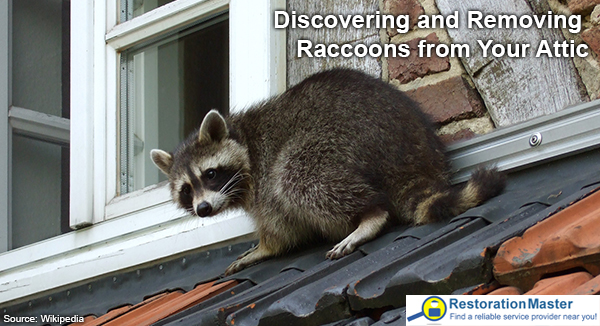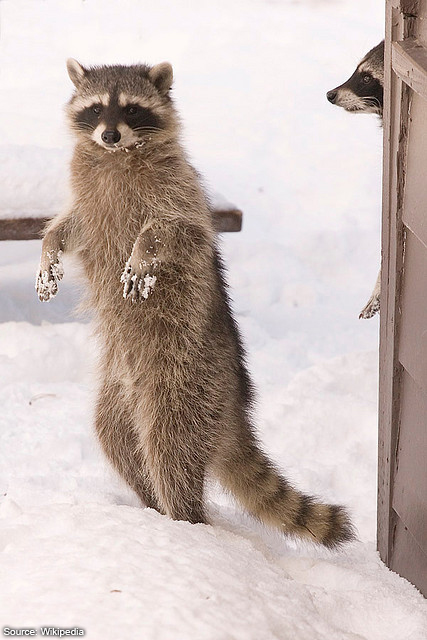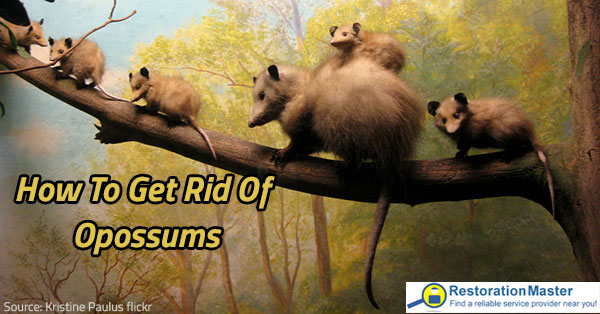Discovering and Removing Raccoons from Your Attic

This little guy is looking for a place to hide
Even during the coldest seasons, homes are never entirely safe from the threat of an animal intrusion especially involving raccoons. Raccoons are crafty creatures that are active year round and they can find their way into basements and attics where they can cause extensive property damage and spread the risk of disease. The best method of raccoon control is preventionPrevention refers to actions taken to reduce the likelihood ... More and if you do discover a raccoon or multiple raccoons living in your attic, it is best to call a wildlife professional to remove them. The following is a guide on how to discover if there are raccoons in the attic and what to do after raccoon removal.
Signs of Raccoons in the Attic
The attic is one of the most appealing areas for intruding animals including raccoons to take up shelter. It provides plenty of space for raccoons to den, especially female raccoons that are about to give birth to a litter, and the attic is usually close to common sources of food for raccoons including garbage and pet food. Most intruding raccoons are female raccoons looking for shelter to bear and raise their litter which makes it very important to determine if there is a single raccoon in your attic or a female with babies before taking action. These are the most common signs of raccoons in the attic:
- Noise: Raccoons make a lot of noise in the attic because they are among the biggest animals that can get into an attic. Unlike smaller animals that may produce scurrying noises, raccoons make harder thumping noises as they walk and sometimes make vocal noises such as growls and cries. Raccoons are nocturnal animals so they are more likely to make noises at night. If a female raccoon with a litter of babies is in your attic, you may hear their crying as well.
- Sight: Raccoons are large enough animals that they cannot hide quickly or easily and they are often seen by homeowners entering or leaving the attic. They can also be seen near garbage cans and other common food sources.
- Entry Point: Another sign that you may have raccoons in the attic is the entry point. Raccoons can easily get near your attic by climbing trees next to your home and the soffit to the roof is not usually secured to keep out animals. Raccoons may tear holes in the wall or soffit near the roof to enter the attic or even enter through a vent opening. Holes in the soffit or walls near the attic are sign of possible animal intrusion.
Getting Rid of Raccoons in the Attic

Raccoons out in the snow
Once you determine that there is a raccoon or multiple raccoons in your attic, you should waste no time taking action to have them removed. Raccoons can cause extensive property damage because they may destroy drywall, insulationInsulation is a material used in buildings to reduce the tra... More, air ducts, wood beams, and other materials looking for bedding material for their young or to make themselves a sleeping area. They can also chew on and destroy electrical wire which can leadLead is a heavy metal that can be toxic to humans, especiall... More to power shortages at best and fires at worst. Property damage is not the only consequence of having raccoons in the attic, they also cause a range of diseases including rabies, distemper, and a number of diseases from their droppings such as salmonella and raccoon roundworm. The potential for severe damage and serious health risks caused by raccoons make it important to act fast to remove them.
The most effective method of raccoon removal is raccoon trapping and in most states, trapping raccoons is illegal so it is best to call a professional that specializes in raccoon control. These trained professionals can safely trap troublesome raccoons as well as any baby raccoons that may be present so they can be relocated in the wild a safe distance from the house. Many wildlife professionals will also help you repairRepair is the act of fixing or restoring damaged property, m... More the entry points to prevent any raccoons from reentering your attic.
After Raccoon Removal
Once you have a professional remove the raccoon from your attic, the job is not entirely complete. If the wildlife professional did not do this as part of their service, the first thing you should do is close up the entry points used by the raccoons by bolting torn holes shut and covering open vents with metal screens. After securing the entry points, you should inspect your entire attic for damage caused by the raccoon such as torn open air ducts and chewed electrical wires. Perhaps the most important part of the cleanup after the raccoon is removed is cleaning the raccoon urine and feces and decontaminating your attic. Remember, raccoon feces and urine are dangerous for harboring diseases so they must be removed carefully. If you are not confident in your ability to effectively remove and decontaminate your attic after a raccoon intrusion, you can contact a professional that specializes in biohazard cleaning to make sure your attic is safe.
Raccoons are one of the most difficult intrusive animals to deal with and they often take up shelter in attics to live and in some cases raise their young. Due to the difficult nature of trapping raccoons, hiring a wildlife professional to trap and remove them is the best option and your attic will also need to be cleaned and decontaminated after the raccoons are removed. Reacting quickly is the key to having the raccoons removed before they cause extensive damage or health problems in your home.










